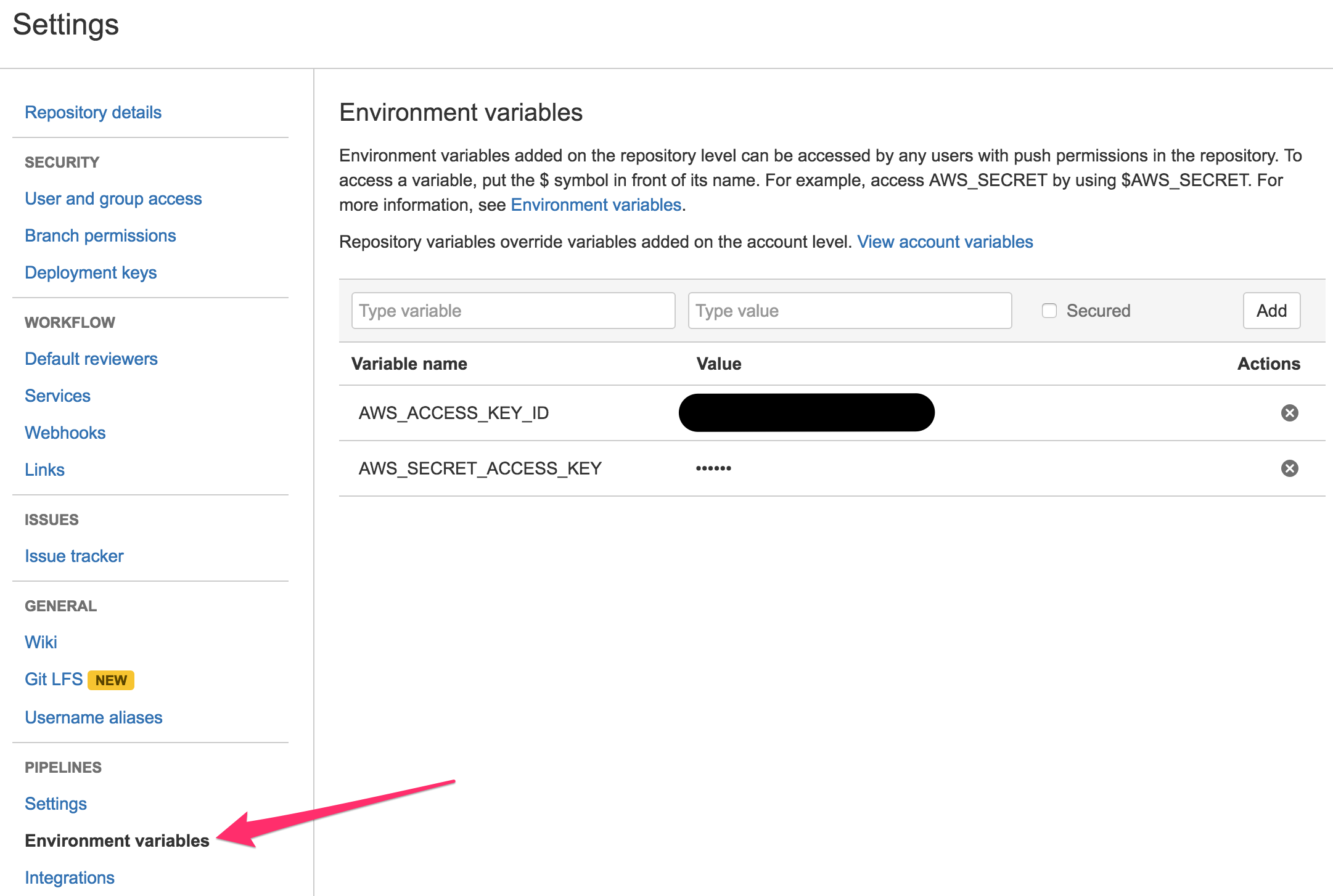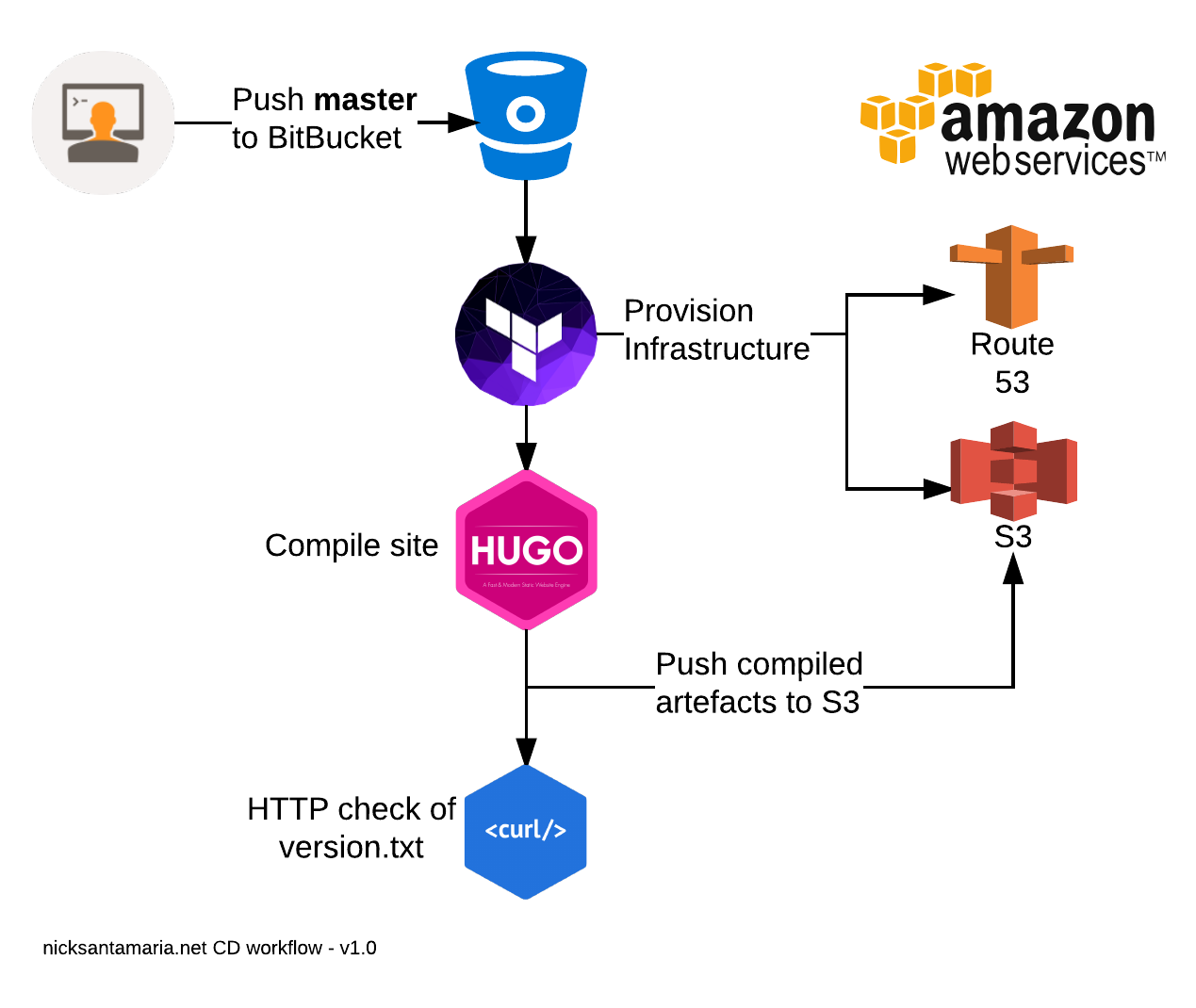Background
A few weeks ago I decided to replace my ageing and bloated Drupal 7 blog. I decided on the following criteria that the solution had to meet:
- The project git repo must be private.
- Hosting infrastructure had to be under my control and completely codified.
- The solution should require very little supporting infrastructure such as databases.
- Deployment of changes to the site or infrastructure must be automated.
These requirements immediately ruled out a few options including GitHub Pages and SaaS blogging platforms like wordpress.org.
In the end I decided on the following architecture:
- BitBucket for free private repo hosting.
- BitBucket Pipelines for CI/CD pipeline.
- Hugo for static site generation.
- AWS S3 for static web hosting.
- AWS Route 53 for DNS.
- Terraform for infrastructure management.
Repository Structure
To ensure simplicity in workflow, I wanted everything to be codified within the main project repo:
- The Hugo site source code.
- The Terraform templates.
- The BitBucket Pipelines build configuration.
Below is the structure I ended up with.
nicksantamaria.net
├── bitbucket-pipelines.yml <-- Pipeline configuration
├── hugo <-- Hugo site source files
│ ├── config.yml
│ ├── content
│ ├── public
│ ├── static
│ └── themes
└── terraform <-- Terraform templates
├── main.tf
└── variables.tf
Terraform Configuration
There are a few AWS resources that are required to host the site on S3.
aws_s3_bucket to host the website files.
resource "aws_s3_bucket" "www" {
bucket = "www.nicksantamaria.net"
acl = "public-read"
force_destroy = true
policy = <<EOF
{
"Version":"2012-10-17",
"Statement":[{
"Sid": "PublicReadGetObject",
"Effect": "Allow",
"Principal": "*",
"Action":["s3:GetObject"],
"Resource":[
"arn:aws:s3:::www.nicksantamaria.net/*"
]
}]
}
EOF
website {
index_document = "index.html"
error_document = "404.html"
}
}
aws_route53_record CNAME record for www.nicksantamaria.net
resource "aws_route53_record" "www" {
zone_id = "XXXX"
name = "www.nicksantamaria.net"
type = "CNAME"
ttl = "300"
records = ["${aws_s3_bucket.www.website_domain}"]
}
aws_s3_bucket for the apex domain redirect.
resource "aws_s3_bucket" "apex" {
bucket = "nicksantamaria.net"
acl = "public-read"
force_destroy = true
policy = <<EOF
{
"Version":"2012-10-17",
"Statement":[{
"Sid":"PublicReadGetObject",
"Effect":"Allow",
"Principal": "*",
"Action":["s3:GetObject"],
"Resource":["arn:aws:s3:::nicksantamaria.net/*"]
}]
}
EOF
website {
redirect_all_requests_to = "www.nicksantamaria.net"
}
}
aws_route53_record A ALIAS record for nicksantamaria.net
resource "aws_route53_record" "apex" {
zone_id = "XXXX"
name = "nicksantamaria.net"
type = "A"
alias {
name = "${aws_s3_bucket.apex.website_domain}"
zone_id = "${aws_s3_bucket.apex.hosted_zone_id}"
evaluate_target_health = false
}
}
If you want to adapt these for your own site:
- Replace ‘nicksantamaria.net’ with your desired domain.
- Replace zone_id = ‘XXXX’ with the zone ID of your route 53 hosted zone.
Continuous Delivery Configuration
I chose BitBucket Pipelines to handle the CD pipeline due to its tight integration with BitBucket, plus it was a great opportunity to evaluate its suitability for future projects.
The first thing I needed to do was set up AWS credentials in BitBucket Pipelines. This is configured in the Repository configuration page in BitBucket.

Each build had to execute the following tasks:
- Validate Terraform templates.
- Provision Terraform resources.
- Compile Hugo site.
- Sync compiled artefact to S3.
Here is this workflow visualised -

Here is the bitbucket-pipelines.yml file I created to achieve this.
image: golang:1.7
pipelines:
branches:
# master is the production branch.
master:
- step:
script:
#
# Setup dependencies.
#
- mkdir -p ~/bin
- cd ~/bin
- export PATH="$PATH:/root/bin"
- apt-get update && apt-get install -y unzip python-pip
# Dependency: Hugo.
- wget https://github.com/spf13/hugo/releases/download/v0.17/hugo_0.17_Linux-64bit.tar.gz
- tar -vxxzf hugo_0.17_Linux-64bit.tar.gz
- mv hugo_0.17_linux_amd64/hugo_0.17_linux_amd64 hugo
# Dependency: Terraform.
- wget https://releases.hashicorp.com/terraform/0.7.8/terraform_0.7.8_linux_amd64.zip
- unzip terraform_0.7.8_linux_amd64.zip
# Dependency: AWS CLI
- pip install awscli
#
# Provision Terraform resources.
#
- cd ${BITBUCKET_CLONE_DIR}/terraform
# Ensure Terraform syntax is valid before proceeding.
- terraform validate
# Fetch remote state from S3 bucket.
- terraform remote config -backend=s3 -backend-config="bucket=tfstate.nicksantamaria.net" -backend-config="key=prod.tfstate" -backend-config="region=ap-southeast-2"
# Ensure this step passes so that the state is always pushed.
- terraform apply || true
- terraform remote push
#
# Compile site.
#
- cd ${BITBUCKET_CLONE_DIR}/hugo
- hugo --destination ${BITBUCKET_CLONE_DIR}/_public --baseURL http://www.nicksantamaria.net --verbose
# Create a file containing the build version.
- echo "${BITBUCKET_COMMIT}" > ${BITBUCKET_CLONE_DIR}/_public/version.txt
#
# Deploy site to S3.
#
- aws s3 sync --delete ${BITBUCKET_CLONE_DIR}/_public/ s3://www.nicksantamaria.net/ --grants read=uri=http://acs.amazonaws.com/groups/global/AllUsers
# Test the live version matches this build.
- curl -s http://www.nicksantamaria.net/version.txt | grep ${BITBUCKET_COMMIT}
Notes
There are a few things worth explaining in more detail.
Dependency setup
The first section of the pipeline is installing dependencies for the rest of the build. I plan on improving this by creating a custom docker image which has all these utilities pre-installed - this would reduce the build time from 2 minutes to 30 seconds.
Terraform remote state
To ensure that the terraform state is preserved between pipelines runs, the state file is stored in a S3 bucket called tfstate.nicksantamaria.net. I created this bucket manually (rather than with Terraform) to ensure there is no risk of the bucket being unintentionally destroyed during a terraform apply.
Version checking
After Hugo compiles the site, an additional file called version.txt is placed into the docroot. This file contains the git commit hash (from $BITBUCKET_COMMIT environment variable). The very last command in the pipeline makes a HTTP request to this file, and ensures the response matches the expected version string.
Conclusion
I am really happy with the end result which achieved all of goals I set out in the beginning.
BitBucket Pipelines is a brand-new service, and had some key features missing compared to competitors like TravisCI and CircleCI.
- Environment variable definition in the build config file.
- Separation of concerns between setup, test and deployment phases of the build.
- Ability to have a subset of build steps shared between branches.
There are a few improvements I plan on making.
- Add CloudFront as a CDN.
- Use a custom docker image for the CD builds to reduce build time.